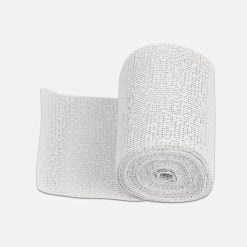No products in the basket.
blogs
How to Choose Medical Gauze
Medical Gauze is used to absorb blood and other exudates from the wound surface in order to clean the wounds. Gauze sponges are disposable and are used in hospitals and medical centers around the globe. Gauze sponges are made up of cotton and other non-woven materials. They are available in many sizes, plys, and fabrics.
Medical gauze pads come in sterile and non-sterile variations. The open weave design of medical gauze sponges aids in the removal of dead tissue from the wound surface. Gauze pads potray moisture wicking properties i.e. they vertically wick fluid from the wound onto any secondary dressing to assist with preventing maceration of skin tissue. In cases of accidentally leaving gauze sponges in bodies, some kinds of gauze sponges are woven with X-ray detectable thread.
Medical Gauze Variations Explained:
- Woven Gauze: typically means that the gauze contains layers of woven cotton layered together into multiple ply sheets.
- Non-Woven Gauze: Non-woven gauze is usually synthetic material made to look like a woven dressing yet maintain the same aeration ability.
Bandages
If you are a patient, a nurse or wound care specialist will dress the wound in the appropriate gauze. It is good to first ask the specialist about the product and procedures before purchasing anything different. It is important to become familiar with the gauze type given, note the name of the product as well as the reference number.
As mentioned previously, the gauze will be one of two types: non-woven or woven. With woven gauze, it is a straight cotton weave. This typically is the cheapest and most used gauze material. For primary dressing applications, woven is typically not recommended. Sterile, woven gauze can be used for a secondary dressing with most wound care applications, but as a primary dressing, for heavy exudating wounds, it will be detrimental to the healing process. The wound can dry and cake around the dressing, making removal both painful and damaging as it can pull up the granulating wound tissue.
Medical Uses of Gauze:
- Stem bleeding – to help to seal the wound to expedite the clotting process;
- Protection from infection – to defend the wound against germs and mechanical damage;
- Absorb exudate – to soak up blood, plasma, and other fluids exuded from the wound, containing it/them in one place and preventing maceration;
- Ease pain – either by a medicated analgesic effect, compression or simply preventing pain from further trauma;
- Debride the wound – to remove slough and foreign objects from the wound to expedite healing;
- Reduce psychological stress – to obscure a healing wound from the view of the patient and others.
Ultimately, the aim of a dressing is to promote healing of the wound by providing a sterile, breathable and moist environment that facilitates granulation and epithelialization. This will then reduce the risk of infection, help the wound heal more quickly, and reduce scarring.
Types of Medical Gauze:
- Antimicrobial gauze is generally used to fend off bacteria and stave off infection and it comes in a variety of types.
- Conforming gauze typically comes in roll form and is a durable, stretchable fabric that adapts to the shape of the affected area in order to securely hold the primary dressing in place during wound healing. It can also be used for controlled compression.
- Gauze sponges are generally used in clinical settings to clean wounds, and they come in woven and non-woven varieties. It’s has an open-weave design that removes dead tissue and excessive exudate from the site.
- Drain sponges are similar to regular gauze sponges, though they have greater absorbency to reduce unnecessary moisture from the wound bed.
- Impregnated gauze is saturated with medications to aid in the wound healing process. This product may contain hypertonic saline to enhance the absorption of drainage, while others are permeated with iodoform to help reduce bacteria that cause foul discharge in tunneling wounds.
- Bordered gauze is an absorbent material that is placed in the center of a fabric adhesive, similar to a household adhesive bandage. It may collect excess exudate as well as maintaining a moist environment for optimal healing.
- Packing gauze often comes in strip form and generally used as a wound filler on wounds to support a healthy wound healing environment. They may be used dry for absorption or soaked in a medication, such as an antimicrobial, to aid in the treatment plan.
How To Apply Medical Gauze:
For deep wounds or wounds that are prone to infection, you may want to consult your physician. Usually, these types of wounds require the utmost attention to maintaining a sterile zone. Doing this means that using sterile gloves, applicator swabs, and of course dressings are the norm. Keep in mind that touching non-sterile items will contaminate gloves, so watch what you touch, so that you don’t cross-contaminate.
- Wash your hands with soap and water. You can also wear gloves.
- Gently wash the wound with a wet piece of gauze or washcloth.
- Place a piece of clean gauze over the wound.
- Apply tape around the edges of the gauze to hold it in place.
Medical Gauze We Stock:
- Paraffin Gauze
- Sterile Gauze Swabs
- Non Sterile Gauze Swabs
- Plaster of Paris Bandages
Different Types of Gauze Article






